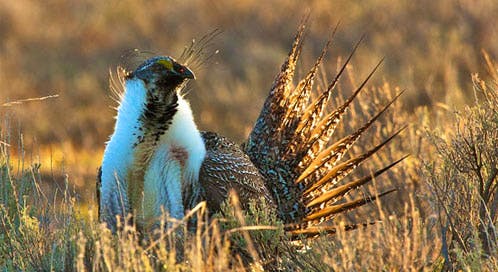As policymakers and land managers struggle to plan sage-grouse conservation on millions of acres of public lands in the West, the bird itself is struggling to survive a multitude of threats on the ground, especially habitat loss and degradation – even barbed wire fences. Fortunately, there is an effective and immediate way to address the threat from fences without political input or complex management plans.

Feathers along the fence line could mean a bird hit the fence, though in this case it was likely a female Northern harrier preening on a fence post (let’s hope!).
Sage-grouse, charismatic fowl known for their elaborate mating dance, are heavy-bodied and low-flying birds. They typically fly to their mating grounds called leks in the pre-dawn, when light conditions make fences difficult to see…and to avoid. While sage-grouse are among the most historically recognizable icons of the American West, they now occupy little more than half of their original range, and current populations are estimated at less than 10 percent of historic levels. Though not a primary threat to sage-grouse, barbed-wire fences have taken their toll on the species.
Fence strikes can happen frequently, depending on the location and habitat use. A 2010 field study in Idaho found significant evidence of sage-grouse collisions with barbed wire fence, and noted that most of the collisions occurred in late March through early April. This is the peak time when males and females are moving to and from leks during mating season.
Luckily, there is something we can do about this situation. One obvious step is to remove problematic fences, and we’re eager to find ways to help land management agencies and private landowners to do so. But where fence removal is not feasible, research also suggests that grouse/fence strikes can be reduced by putting markers on fences so that grouse can see the skinny wires before they fly into them. Markers are made of 4-inch pieces of plastic that can be easily clipped onto the wire strands about every three to four feet of fencing. It is most important to mark fences near leks and nesting and wintering grounds, where sage-grouse spend much of their time. A study of sage-grouse and fence collisions by the Wyoming Game and Fish Department indicated that markers reduced sage-grouse mortality from fence collisions in the study area by 61 percent during the study period. And the Idaho study mentioned above found that marked fences reduced collision rates by approximately 83 percent.

Defenders employee Russ Talmo placing plastic tags on barbed wire fence near a sage grouse lek to reduce the chance of sage grouse hitting the fence.
Defenders of Wildlife works hard to conserve sage-grouse, primarily through policy work and legislative action. But we also look for opportunities on the ground, working with government agencies and landowners to improve habitat conditions for the bird. We find that working out on the landscape where these critters live can be highly effective conservation work as well – and we like to get our boots dirty! Last month, and for the second year in a row, Defenders partnered with the Natural Resources Conservation Service (NRCS), and two willing and helpful landowners who were pleased to have our assistance in marking their fences for sage-grouse. Two Defenders employees headed to central Montana to place thousands of markers on fences near sage-grouse leks. These markers were donated by NRCS and we worked with an NRCS representative who helped us determine which fences could pose the biggest threat to sage-grouse, and then came along with us to help mark them. The first location was on land owned by a private landowner who was born, raised, and operates his family ranch near Winifred, Montana. The second location was on property owned by the American Prairie Reserve, a growing wildlife project dedicated to purchasing and conserving prairie lands adjacent to the Charles M. Russell National Wildlife Refuge near Malta, Montana. Battling cold winds at one location and fierce hordes of mosquitos at the other, we marked more than 10 miles of fences.

Private rancher, NRCS employee, and Defenders employee developing the plan of attack for marking fences. AKA looking at a map.
So while Defenders’ policy analysts work hard to ensure conservation for sage-grouse at the state and federal level, Defenders’ field representatives are simultaneously working in the field on local solutions to help the birds. Flagging fences with markers is a relatively quick and easy job that can potentially save many sage-grouse from unfortunate injury or death – so we plan to continue to partner with NRCS, and other agencies and private landowners in Montana and perhaps elsewhere to mark many more miles of fences across the landscape!
Kylie Paul is the Rockies & Plains Representative for Defenders of Wildlife



